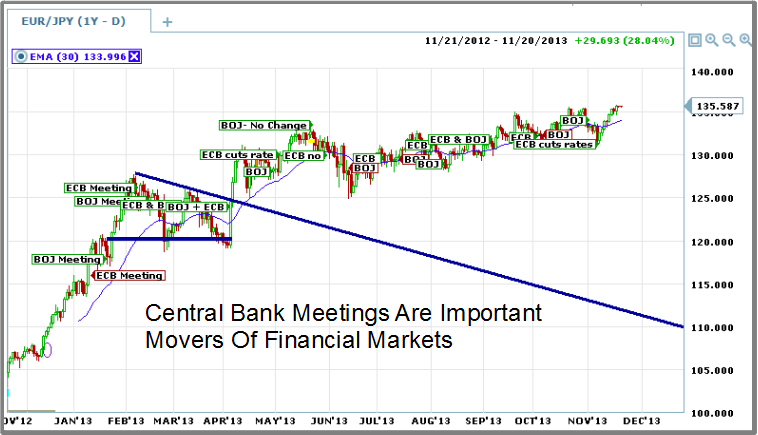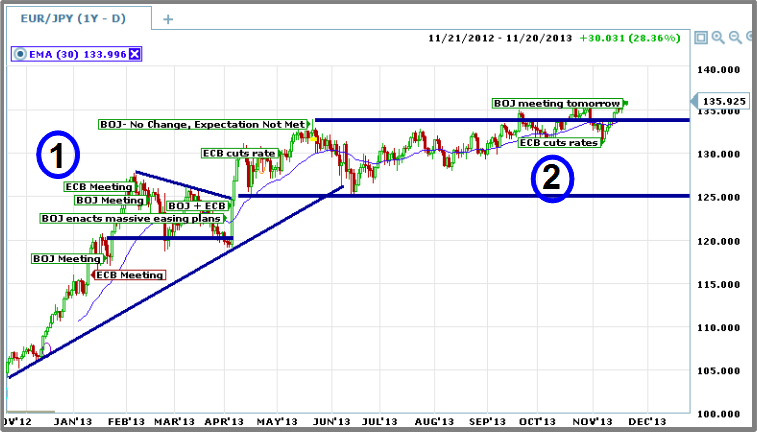Market Timing With Central Bank Meetings
Anyone who watches the economy and/or trades currencies will tell you that the world’s central banks have a lot of power to move the markets. It only makes sense if you think about it. Market movements are based on a combination of underlying fundamentals, market sentiment and technical analysis. Underlying fundamentals include key interest rates and other monetary policies such as the massive rounds of quantitative easing (QE) seen round the world over the past few years. The central banks control the key interests rates and the flow of money so it stands to reason that central bank meetings, especially ones where a change to policy is expected, are good targets for market moving events to occur. Binary options traders can profit by keeping up with these meetings.
Market Timing For Binary Options
Now I’m sure that by this point you are beginning to agree with me and may even be thinking that this is going to be easy but it’s not, let me assure you. The maneuvering of the worlds central banks is like a massive game of chess where each banks country stands to profit or lose from policy. For one thing, the central bank meetings are not in synch. Each bank, and for the purposes of this article I am focusing on the Federal Open Market Committee, the European Central Bank and the Bank of Japan, is on its own schedule. Even though each bank meets regularly according to its own schedule none of the banks meet with regularity in relation to each other.
This is what I mean; the FOMC meets every 6 weeks, releasing policy statements on Wednesday afternoon. The BOJ meets every every four weeks with no specific set day; this usually means once per month but can mean twice in one month every once in a while. The ECB meets twice each month, once near the beginning and once near the end. The early meeting is when they usually announce policy changes but can also do so at the second meeting if needed. Since the FOMC meets every 6 weeks it is possible that there will be no meeting in some months. It also means that there could be one or two meetings of the BOJ and/or the ECB in between each meeting of the FOMC, depending on the schedule. It is also possible that on any given month the meetings could be in the same week or even on the same day, or not. Imagine playing chess when your opponent could make two moves for each of yours, or if they could make their move while you were making your move.
Adding to the confusion are the meeting minutes. Each central bank releases the minutes to their meetings a few weeks after the actual meeting. The minutes reveal what each participant has to say about the policy and can give indications of what may happen in the future. Needless to say the minutes can have a big effect on sentiment and expectations. Other factors affecting the economic chess game is data. Sometimes data supports current policy, sometimes it doesn’t and only provides volatility to the market.
The affects of the central banks can be seen most directly in the currency markets but this technique can be used in other markets as well. I get the best results timing major indices, currency pairs and gold but there are other markets affected by the central banks. For this example I will use the EUR/JPY. I have marked on the chart when policy meetings for each respective central bank were held. Notice how in some months the BOJ meets first and in some months it’s the ECB. Also notice that there are three times that both meetings occurred on the same day. From month to month there is some movement of the pair centered around each of the central bank meetings. Most of the movements are small, based more on expectations than changes to the fundamentals. Some of the movements are large, based on real change to the balance of money between one nation and another. A major currency event occurred during this time period when the BOJ began a historic QE program in answer to decades of economic stagnation.

Now let’s look at the chart again. This time I have removed some of the tags for meetings where no changes to policy or interest rates were made. What is left are meetings where the underlying fundamentals changed or where expectations of change were very high. There are two distinct periods on the chart. The first is a time when expectation for change were high and that change was met or exceeded. This was done with massive injections of capital into the Japanese economy with a target of doubling the currency base. The second period is a time when no changes were made but QE policy was still in effect. The ECB reduced interest rates twice in during the second period but this move was pale in comparison to the QE plans put in place by the BOJ.

Looking back to January we can see the pair rally up to a high in early February. This rally was driven by the expectations that QE would start in Japan. This is the rally leading up to and after the election of Shinzo Abe and the expectation Kuroda would become BOJ chief. There are then a couple of meetings of both the ECB and the BOJ between February and early March with no changes to policy from either, resulting in a triangle formation. In early March Kuroda is confirmed as BOJ chairman, the board meets and QE is enacted for Japan causing the EUR/JPY to rally again. The rally led to a break out of the triangle with an eventual peak coincident with yet another BOJ meeting. The next 7 months see no change from either bank, resulting in a trading range for the pair.
The take away. Central bank meetings are an important driver of the markets, especially the currency markets. Not only are the meeting themselves important but also the minutes, the statements and the expectations. Binary options traders can profit from these meetings by using them as targets for changes in market direction or continuation signals. In between the meetings day to day movements can be timed using changes in expectations to policy. Keeping up with the meetings, and the expectations, is the key. The best way for binary traders to use this is to make it a part of your normal fundamental analysis. An upcoming meeting could be a time to get into a trade, it may also be the cut off for expiry on a current trade. Remember though, not all meetings will result in a major shift in asset values, only when major changes to policy are made. However, the interplay between the banks, the economy and the markets will result in numerous short term trading opportunities as well.